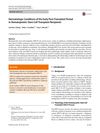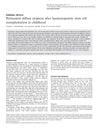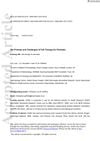TLDR A 12-year-old boy had severe shingles and skin damage after a stem-cell transplant.
A 12-year-old boy developed rapidly spreading, severely pruritic C3-C4 shingles three months after undergoing a matched unrelated haematopoietic stem-cell transplantation (HSCT) for relapsed acute myeloid leukaemia. Despite early treatment with intravenous aciclovir, he experienced full C3-C4 dermatome skin erosion to the dermis and secondary hair loss.
 5 citations
,
October 2018 in “American Journal of Clinical Dermatology”
5 citations
,
October 2018 in “American Journal of Clinical Dermatology” Skin problems are common after stem cell transplants, and early treatment by dermatologists can improve patient outcomes.
98 citations
,
March 2019 in “Frontiers in immunology” Damaging mutations in NFKB2 cause a severe and distinct form of primary immunodeficiency with early-onset and often ACTH-deficiency.

Chemotherapy can cause skin issues and hair loss, and this guide explains how to manage them.
 16 citations
,
March 2017 in “Bone Marrow Transplantation”
16 citations
,
March 2017 in “Bone Marrow Transplantation” Some children who had stem cell transplants developed permanent hair loss, especially when treated with a drug called busulphan.
 15 citations
,
May 2021 in “British journal of dermatology/British journal of dermatology, Supplement”
15 citations
,
May 2021 in “British journal of dermatology/British journal of dermatology, Supplement” Cell therapy shows promise for treating severe psoriasis but needs more research to confirm safety and effectiveness.



